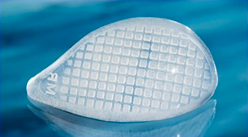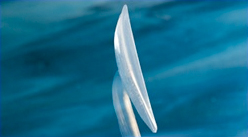Cosmetic Facial Implants
Facial Implant
As a highly trained plastic surgery facial implant specialist, Dr. Barry Eppley has extensive experience helping facial plastic surgery patients with their aesthetic needs through facial skeletal augmentation. Dr. Eppley has compiled an extensive amount of information about this procedure and encourages patients to visit the facial implants before and after page to view examples of past patients.
CONTEMPORARY FACIAL IMPLANTS

The technological developments in medical biomaterials and an improved understanding of the influence of hard and soft tissue on the face has made the use of facial implants a routine procedure predictable results. While once reserved mainly for facial bone deformities, they are now an integral part of contemporary management of facial aging as well as such conditions as facial asymmetry and for facial reshaping. Facial implants come in two basic materials, silicone (which is by far the most commonly used) and medpor (porous polyethylene). Each material has its own advantages and disadvantages, neither facial implant material is perfect. Regardless of the implant’s composition, they are all placed in a subperiosteal position right next to the bone. Most of the time, the implant is secured to the bone by small screws so there is no chance of shifting or implant migration.
As has evolved over the past two decades, facial implants now exist for ever conceivable facial bone location. Options include implants for the chin, pre jowl, jawline, jaw angle, cheek, paranasal, premaxillary, maxillary, nasal, tear/trough infraorbital rim and temporal areas.
CHIN IMPLANTS
 Augmentation of a weak chin is the original facial implant design. Introduced decades ago, it has evolved from a simple ‘button’ implant on the front part of the chin to over a dozen chin implant styles.
Augmentation of a weak chin is the original facial implant design. Introduced decades ago, it has evolved from a simple ‘button’ implant on the front part of the chin to over a dozen chin implant styles.  Extended chin implants are the standard design today as they wrap around the chin to blend into the side of the jawline for a smoother and more confluent jawline appearance. Chin implants come in tapered and square width designs, differing amounts of horizontal and vertical augmentations as well as combined chin-prejowl shapes. All of these chin implant designs help make the jawline stronger, give more chin projection and may help smooth out jowls and pick up some loose neck skin.
Extended chin implants are the standard design today as they wrap around the chin to blend into the side of the jawline for a smoother and more confluent jawline appearance. Chin implants come in tapered and square width designs, differing amounts of horizontal and vertical augmentations as well as combined chin-prejowl shapes. All of these chin implant designs help make the jawline stronger, give more chin projection and may help smooth out jowls and pick up some loose neck skin.
JAW ANGLE AND JAWLINE IMPLANTS
 While augmenting the front part of the jaw has been around a long time, augmentation of the back part of the jaw (jaw angles) is a more recent facial implant innovation. To create stronger and more defined jaw angles, implants can be placed from inside the mouth that make it look wider, vertically longer or a combination of both. Augmenting the jaw angles is often combined with chin implants to create an overall jawline enhancement.
While augmenting the front part of the jaw has been around a long time, augmentation of the back part of the jaw (jaw angles) is a more recent facial implant innovation. To create stronger and more defined jaw angles, implants can be placed from inside the mouth that make it look wider, vertically longer or a combination of both. Augmenting the jaw angles is often combined with chin implants to create an overall jawline enhancement.
CHEEK IMPLANTS
 Cheek implants come in a wide variety of sizes and shapes to fill differing midface needs. The most common and historic use of cheek implants is to augment flat cheekbones or give cheekbones more prominence. This is the classic concept of cheek augmentation also known as malar implant enhancement since they sit on top of the zygoma or malar bone.
Cheek implants come in a wide variety of sizes and shapes to fill differing midface needs. The most common and historic use of cheek implants is to augment flat cheekbones or give cheekbones more prominence. This is the classic concept of cheek augmentation also known as malar implant enhancement since they sit on top of the zygoma or malar bone.
 Cheek implants have also been developed to help lift tissue that have fallen off the cheekbones and fill in gaunt or sunken areas underneath the cheeks that have occurred due to fat loss from aging or certain medical conditions. These are known as submalar cheek implants as they partially add volume to the area right under the cheek or malar region known as the submalar cheek zone.
Cheek implants have also been developed to help lift tissue that have fallen off the cheekbones and fill in gaunt or sunken areas underneath the cheeks that have occurred due to fat loss from aging or certain medical conditions. These are known as submalar cheek implants as they partially add volume to the area right under the cheek or malar region known as the submalar cheek zone.
Malar and submalar cheek implants have also been combined to create a cheek implant style that combines both midfacial zones of augmentation. This is known as a malar shell implant or a combined malar-submalar implant. This type cheek implant produces the greatest amount of midface lift and volume augmentation.
TEAR TROUGH/INFRAORBITAL RIM IMPLANT
 Grooves or indentations along the lower eyelid and cheek junction develop from either aging or from a natural orbital rim bony deficiency. They create ‘dark circles’ and a very visible depression under the eyes. While more commonly treated by synthetic injectable fillers or fat injections, implants have been developed to provide a permanent augmentation of the infraorbital rim from the more inner tear trough area out to the cheekbone.
Grooves or indentations along the lower eyelid and cheek junction develop from either aging or from a natural orbital rim bony deficiency. They create ‘dark circles’ and a very visible depression under the eyes. While more commonly treated by synthetic injectable fillers or fat injections, implants have been developed to provide a permanent augmentation of the infraorbital rim from the more inner tear trough area out to the cheekbone.
NASAL IMPLANT
 Building up a low or flat nasal bridge is most easily done with a nasal implant. When properly placed and not oversized, it can have very successful results without long-term complications. Use of a nasal implant is used around the world to rapidly create a strong dorsal nasal profile that is permanent. They can be used alone or in conjunction with a more complete overall rhinoplasty.
Building up a low or flat nasal bridge is most easily done with a nasal implant. When properly placed and not oversized, it can have very successful results without long-term complications. Use of a nasal implant is used around the world to rapidly create a strong dorsal nasal profile that is permanent. They can be used alone or in conjunction with a more complete overall rhinoplasty.
PARANASAL AND PREMAXILLARY IMPLANTS
 Building out the base of the nose is known as augmentation of the bony pyriform aperture. This is the bone area that surrounds the open nasal airway and extends from under the nose up along its sides to below the eye area. The paranasal area sits right under the nostril while the premaxillary area goes across the base of the nose. Facial implants exist for each of these areas or is combined into a single paranasal-premaxillary implant. (also known as peri-pyriform implant)These implants help push out the nose to create the appearance of greater lower midface projection.
Building out the base of the nose is known as augmentation of the bony pyriform aperture. This is the bone area that surrounds the open nasal airway and extends from under the nose up along its sides to below the eye area. The paranasal area sits right under the nostril while the premaxillary area goes across the base of the nose. Facial implants exist for each of these areas or is combined into a single paranasal-premaxillary implant. (also known as peri-pyriform implant)These implants help push out the nose to create the appearance of greater lower midface projection.
TEMPORAL IMPLANTS
 The newest facial implant design is for temporal hollows. Sunken or indented temples can be permanently augmented by placing an implant on top of the temporalis muscle and under its investing fascia.
The newest facial implant design is for temporal hollows. Sunken or indented temples can be permanently augmented by placing an implant on top of the temporalis muscle and under its investing fascia.
In addition to helping facial implants patients and providing custom implants for each procedure, Dr. Eppley performs an array of surgical and non-surgical procedures to help rhinoplasty, face lift, cheek implant and Botox patients.
Facial Implants – Before Surgery
If indicated the value of chin or cheek implants is pointed out as part of a more complete facial rejuvenation approach or as standalone procedures to enhance weak facial bone areas. he specific facial areas to be improved are pointed out and discussed. Often patients do not recognize the value of implant volume enhancement in achieving their facial goals when considering other procedures. For this reason, computer imaging may be used to show their benefits. Cheek and chin implants are available in different materials and the advantages or disadvantages of each type is reviewed.
Facial Implants – Operation
Whether done as an isolated procedure or as part of other facial rejuvenation procedures, cheek and chin implants are done under general anesthesia. They are placed either through an incision in the mouth or a small skin incisions under the chin. In some cases, cheek implants may be placed through a lower eyelid incision if a blepharoplasty is also being done. The implant(s) may be secured to the bone with either screws or sutures to prevent postoperative shifting. All incisions are closed with dissolvable sutures.
Facial Implants – After Surgery
Implanted facial sites do not need dressings although one may be applied if other face-lifting procedures are being done. Bruising is minimal but swelling will take several weeks to completely subside and see the final result. Complications with facial implants are very infrequent. Despite being a foreign body, implants are well tolerated in facial areas and infection is very uncommon. More likely concerns may be aesthetic in nature such as the size or position of the implant(s).

North Meridian Medical Building
Address:
12188-A North Meridian St.
Suite 310
Carmel, IN 46032
Contact Us:
Phone: (317) 706-4444
WhatsApp: (317) 941-8237
